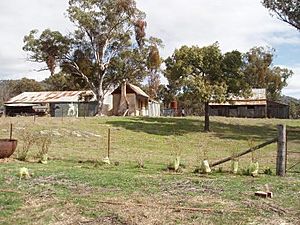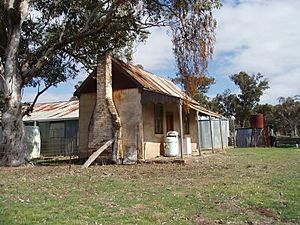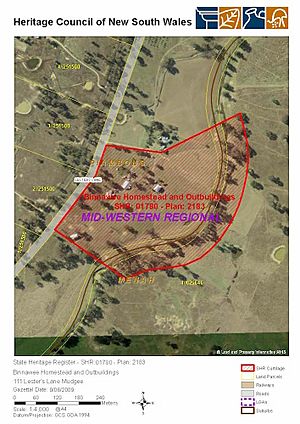Binnawee Homestead facts for kids
Quick facts for kids Binnawee Homestead |
|
|---|---|

View of outbuildings from the homestead
|
|
| Location | 111 Lester's Lane, Mudgee, Mid-Western Regional Council, New South Wales, Australia |
| Built | 1850–1900 |
| Owner | DB & ME Lester |
| Official name: Binnawee Homestead and Outbuildings; Binnawee group complex | |
| Type | state heritage (built) |
| Designated | 9 June 2009 |
| Reference no. | 1780 |
| Type | Homestead Complex |
| Category | Farming and Grazing |
| Builders | Unknown |
| Lua error in Module:Location_map at line 420: attempt to index field 'wikibase' (a nil value). | |
Binnawee Homestead is a very old and important house located in Mudgee, New South Wales, Australia. It's a "heritage-listed" site, meaning it's protected because of its historical value. This homestead, along with its other buildings, was mostly built between 1850 and 1900. It was officially added to the New South Wales State Heritage Register on 9 June 2009, recognizing its special place in history.
Contents
A Look Back in Time: History of Binnawee Homestead
Binnawee Homestead has a long and interesting past, stretching back to the original Aboriginal people of the land and the first European settlers.
Who Lived Here First? The Wiradjuri People
For thousands of years before Europeans arrived, the Wiradjuri Aboriginal people lived in the Mudgee area. The name "Mudgee" itself comes from the Wiradjuri word Moothi, which means "Nest in the Hills." This shows how deeply connected the land is to its first inhabitants.
Early European Settlers in Mudgee
The first European to cross the Cudgegong River in 1821 was James Blackman. Soon after, Lieutenant William Lawson explored the area and later claimed a large piece of land. The first permanent European settlers on the Cudgegong River were George and Henry Cox, who started a farm called Menah.
At first, there were conflicts between the European settlers and the Wiradjuri people. This was often about land and food sources. In 1824, a period of martial law was declared, which led to many losses for the Wiradjuri.
The town of Mudgee was planned in 1823 and officially recognized in 1838. It quickly grew, with houses, hotels, a hospital, and shops. By 1841, Mudgee was a small but busy community.
Gold Rush and Growth
In 1851, Mudgee had about 200 people. But this changed dramatically when gold was discovered nearby. While Mudgee didn't have gold itself, it became a busy town for miners heading to places like Hargraves, Gulgong, and Hill End. Some of these gold towns temporarily grew to 20,000 people!
As the gold rush slowed down in the late 1800s, Mudgee continued to thrive thanks to its strong wool industry. A German immigrant, Adam Roth, also started the local wine industry in the 1850s, which is still important today.
The Families of Binnawee Farm
Binnawee has been home to several important families over the years.
The Cox and Lewis Families
Henry Cox was the first European owner of the land where Binnawee stands. He bought it in 1834. In 1852, Henry Cox sold the property to William Lewis. It's believed that William Lewis built the main two-story house, which was first called "LoisAlle." This house was built in the Georgian style, which was popular at the time.
The Blackman Brothers
By 1862, William Lewis faced financial difficulties, and his property was sold. "LoisAlle" was bought by the Blackman brothers, William Richard and Samuel Alfred. They were important landowners in the Mudgee area. In 1869, William Blackman became the sole owner.
The Cox and Stewart Families
In 1878, William Blackman sold the property to George Henry Cox, a well-known farmer in Mudgee. George Henry Cox combined "LoisAlle" with his other land. It was around this time, in the late 1890s, that the property became known as "Binnawee."
Before he passed away in 1901, George Henry Cox gave the property to his son-in-law, George Stewart. George Stewart and his children moved into Binnawee in 1900. He was a very active member of the Mudgee community, serving as mayor and a Justice of the Peace. He was often called the "squire of Binnawee."
The Lester Family's Long History at Binnawee
In 1923, George Stewart leased Binnawee to Dr. Charles Lester and his son, Bruce. Dr. Charles Lester was a doctor and pharmacist from Mudgee. Bruce Lester, also a pharmacist, served in World War I.
Bruce and his wife, Mabel, lived at Binnawee and used it mainly for sheep farming, along with some cattle. They also bred racehorses.
In 1944, Bruce Lester became ill. His 16-year-old son, David, took over managing the farm. In 1948, Bruce Lester bought the Binnawee homestead from George Stewart's family. The farm grew to about 2,500 acres (1,012 hectares).
In 1950, David Lester married Mary Grant. They built a new house on Binnawee in 1955. Over the years, the farm has become smaller, now about 120 hectares (297 acres), but it still raises sheep and cattle. David and Mary, along with their daughters, have also started growing olives.
What Does Binnawee Homestead Look Like?
Binnawee Homestead is located a few kilometers north-west of Mudgee. It's a working farm, but the protected area focuses on the old buildings from the mid-1800s.
The Main House
The main homestead building was likely built around 1855. It's a large, but not overly fancy, house built in the Georgian style. This style was common in early Australian homes.
The house is made of light red bricks. The front of the house has a balanced look, with windows and doors placed evenly. The roof is steeply sloped and still has its original wooden shingles under the corrugated iron. Two tall brick chimneys stick out from the roof.
A covered verandah (a porch) goes around the ground floor. It has a curved roof supported by wooden posts. The front of the house has two sets of French doors with shutters, along with a central front door. Many windows still have their original glass.
Inside, the house has a clear difference between the main rooms at the front and smaller rooms at the back. The ceilings are all the same height. The front rooms were used as a dining room and living room by the Lester family. The dining room has fancy wallpaper and a decorative border.
The stairs are narrow and steep, with a classic mid-Victorian design. The house has beautiful cedar wood details, though the fireplaces have been painted. Many walls and even some ceilings are covered in wallpaper from different time periods.
Binnawee was one of the first houses in the Mudgee area to have electricity, installed in 1923. Some rooms still have the original pull-cord light switches!
Other Important Buildings
Binnawee Homestead isn't just one house; it's a group of old buildings that show what life was like on a farm long ago.
The Kitchen Block
A covered walkway connects the main house to the kitchen block. This building might have been the original homestead. It's made of brick and has two main rooms. Inside, you can still see the original wooden shingles on the roof.
A special tradition started here: visitors who stayed for more than a week would carve their initials into the kitchen door. There are hundreds of initials there, each with a story! Sadly, this building was badly damaged by storms in 2001.
The Workshop
Near the main house is a building made of stone rubble. It was first built as a conservatory (a type of greenhouse) in the early 1900s by George Stewart's sisters-in-law. Later, the Lesters used it as a dairy and then a workshop. The clay for the bricks and the stone for this building probably came from the farm itself.
The Stables
The stables are located a bit further from the house. The original brick part of the stables, with a loft, is thought to be as old as the kitchen block. Over time, more sections were added. The roof is mostly corrugated iron, but some parts still have old flat iron tiles.
The Workman's Cottage
Close to the stables is a small cottage made of concrete, built around 1923. This early concrete building has held up very well over the years.
The Shearing Shed
The shearing shed, located further west, is very old in parts. It's made of timber and corrugated iron and has been expanded many times by the Lester family.
The Well
An old well from the 1800s is still intact near the creek below the homestead.
Current Condition of the Buildings
The main homestead hasn't been lived in since 1970 and has some storm damage. It needs urgent repairs to stop it from getting worse. The old kitchen block is in poor condition due to the 2001 storms. The stables and shearing shed are in fair condition and are still used regularly. The workshop and workman's cottage also need structural work.
Because people have lived and worked on this property for so long, there's a good chance that archaeologists could find interesting things buried there.
Why is Binnawee Homestead Important?
Binnawee Homestead and its outbuildings are very important to the history of New South Wales for several reasons.
A Glimpse into the Past
This group of buildings is a rare and well-preserved example of a mid-1800s farm. It shows how wealthy farmers lived and worked during that time. The main house is a beautiful and rare example of an intact Georgian-style home from the mid-19th century. The other buildings, like the stables and shearing shed, show different building materials and techniques used back then.
Connections to Important People
Many important people in local and state history have owned or lived at Binnawee. These include William Lewis, the Blackman brothers, and members of the Lester family. Henry Cox was a pioneer in the Mudgee area. George Henry Cox was a very important politician and farmer in New South Wales.
A Special Place for the Community
Binnawee Homestead is important to the Mudgee community because it represents the early farming settlements in the area. It's one of the oldest and most complete groups of farm buildings in the district. The main house is the earliest two-story home in the area and the only one with clear Georgian design.
Learning from the Past
The homestead and its buildings offer a great chance to learn about old building materials and methods. Because the farm has been used continuously since the early 1800s, there's a lot of potential for archaeological research to uncover more about its history.
A Rare Survivor
Binnawee Homestead is rare because the main house is almost perfectly preserved from the 1850s. It's even more special because its working farm buildings, like the stables and shearing shed, are still standing and some are still in use. It's unique in the wider Central West region for its style and age.
Images for kids






